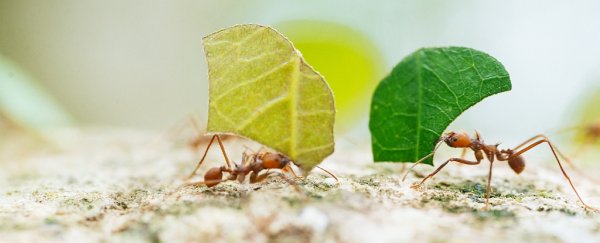New evidence suggests that the chemical trails ants leave to communicate where to go might not be produced by ants after all - but the microbiome in their abdomens.
We're only just starting to delve into the complex relationship humans have with the microbes our bodies host. Now it looks like insects might have a similarly complex relationship.
This fascinating and bizarre discovery concerns the leafcutter ant species Atta sexdens rubropilosa, native to the Americas - from Texas in the United States to northern Argentina in South America.
These ants - and several others - produce a type of chemical compound called pyrazine. It's a key ingredient in the pheromone trails these social insects leave for other ants.
Having a scent trail helps guide the other ants to sources of food, and back to the nest.
Biologists from the University of São Paulo in Brazil have now discovered that a bacterium called Serratia marcescens that lives in the leafcutter ant's gut is somehow involved in the production of this scent. And they found this link in several ant colonies.
What they are less sure about is how this works.
"Are the trail pheromones produced by bacterium S. marcescens, or does S. marcescens only help by somehow adding to the whole process?" says microbial chemist Mônica Tallarico Pupo.
"We intend to investigate in search of answers."
The discovery was made quite by accident. The researchers were looking for microbes that could help the ants protect themselves from parasitic fungi.
To do this, they collected part of an ant colony in the field, including the queen, and set them up in their laboratory, isolating the bacteria in and on the ants and putting them in culture medium to study.
This is when lead author and PhD student Eduardo Afonso da Silva Junior noticed that the cultured S. marcescens bacterium had the same smell as the ants.
"We decided to investigate the volatile compounds produced by this bacterium and discovered the pyrazines, among which there was a molecule not described in the scientific literature," Pupo said.
"We found both pyrazines and bacteria in the ants' poison glands. We don't know for sure if their synthesis is shared: maybe the microorganism produces the aromatic compounds and the ants store them in their glands."
Other ants use pyrazines too. Fire ants, Solenopsis invicta, use them for alarm signalling, while the Madagascan ant Eutetramorium mocquerysi uses them for trail signalling.
So too do the European ants Manica rubida, Myrmica rubra and Tetramorium caespitum - which can lead to confusion when they get mixed up and start following the trail of another species living nearby.
The team intends to examine more ant species to determine if they can find similar bacteria. They also intend to study leafcutter ants in greater detail to try and narrow down the pyrazine production mechanism.
"We plan to test techniques to remove the bacteria from the ants and observe whether the compounds continue to be produced," Pupo said.
The research has been published in the journal Scientific Reports.
